Bendigo Tours & Travel: Project Management Case Study Analysis Report
VerifiedAdded on 2023/04/22
|20
|2963
|52
Project
AI Summary
This project management case study focuses on the development of an information system for Bendigo Tours & Travel. The project scope includes online and hotel reservation systems, catering, and social media integration. The document details stakeholder management strategies, including a stakeholder register and mapping. It presents a team contract outlining roles and responsibilities, followed by a financial analysis projecting costs and benefits. An Agile SDLC model is selected, and the project is broken down into a work breakdown structure. A Gantt chart and critical path method are used for scheduling, and schedule trade-offs are discussed. The communication plan outlines how project information is shared. Finally, the case study identifies potential risks and provides a risk register, along with a discussion of project success monitoring.

Running head: PROJECT MANAGEMENT
Case Study: Bendigo Tours & Travel
Name of the Student
Name of the University
Author’s Note
Case Study: Bendigo Tours & Travel
Name of the Student
Name of the University
Author’s Note
Paraphrase This Document
Need a fresh take? Get an instant paraphrase of this document with our AI Paraphraser
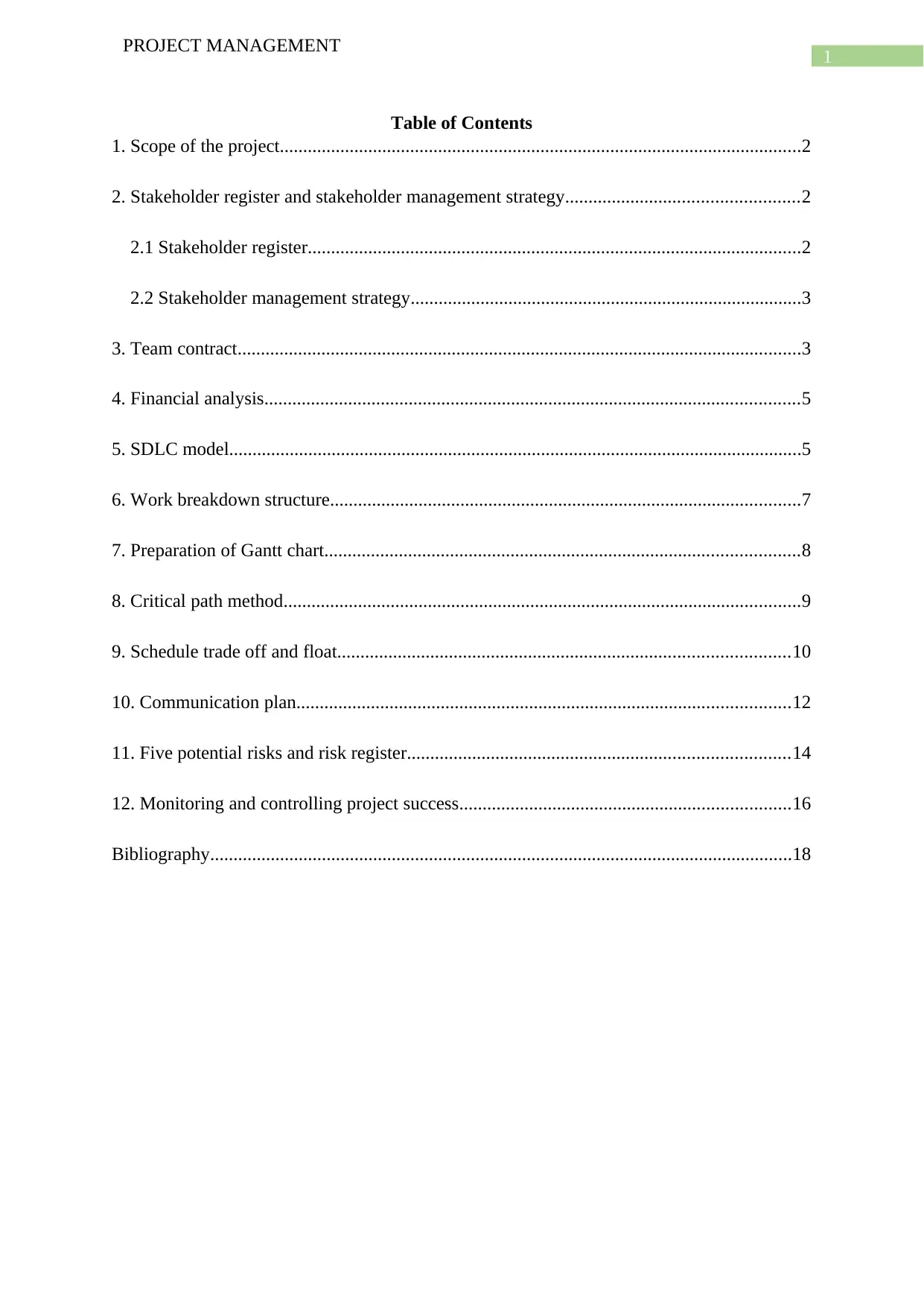
1
PROJECT MANAGEMENT
Table of Contents
1. Scope of the project................................................................................................................2
2. Stakeholder register and stakeholder management strategy..................................................2
2.1 Stakeholder register..........................................................................................................2
2.2 Stakeholder management strategy....................................................................................3
3. Team contract.........................................................................................................................3
4. Financial analysis...................................................................................................................5
5. SDLC model...........................................................................................................................5
6. Work breakdown structure.....................................................................................................7
7. Preparation of Gantt chart......................................................................................................8
8. Critical path method...............................................................................................................9
9. Schedule trade off and float.................................................................................................10
10. Communication plan..........................................................................................................12
11. Five potential risks and risk register..................................................................................14
12. Monitoring and controlling project success.......................................................................16
Bibliography.............................................................................................................................18
PROJECT MANAGEMENT
Table of Contents
1. Scope of the project................................................................................................................2
2. Stakeholder register and stakeholder management strategy..................................................2
2.1 Stakeholder register..........................................................................................................2
2.2 Stakeholder management strategy....................................................................................3
3. Team contract.........................................................................................................................3
4. Financial analysis...................................................................................................................5
5. SDLC model...........................................................................................................................5
6. Work breakdown structure.....................................................................................................7
7. Preparation of Gantt chart......................................................................................................8
8. Critical path method...............................................................................................................9
9. Schedule trade off and float.................................................................................................10
10. Communication plan..........................................................................................................12
11. Five potential risks and risk register..................................................................................14
12. Monitoring and controlling project success.......................................................................16
Bibliography.............................................................................................................................18
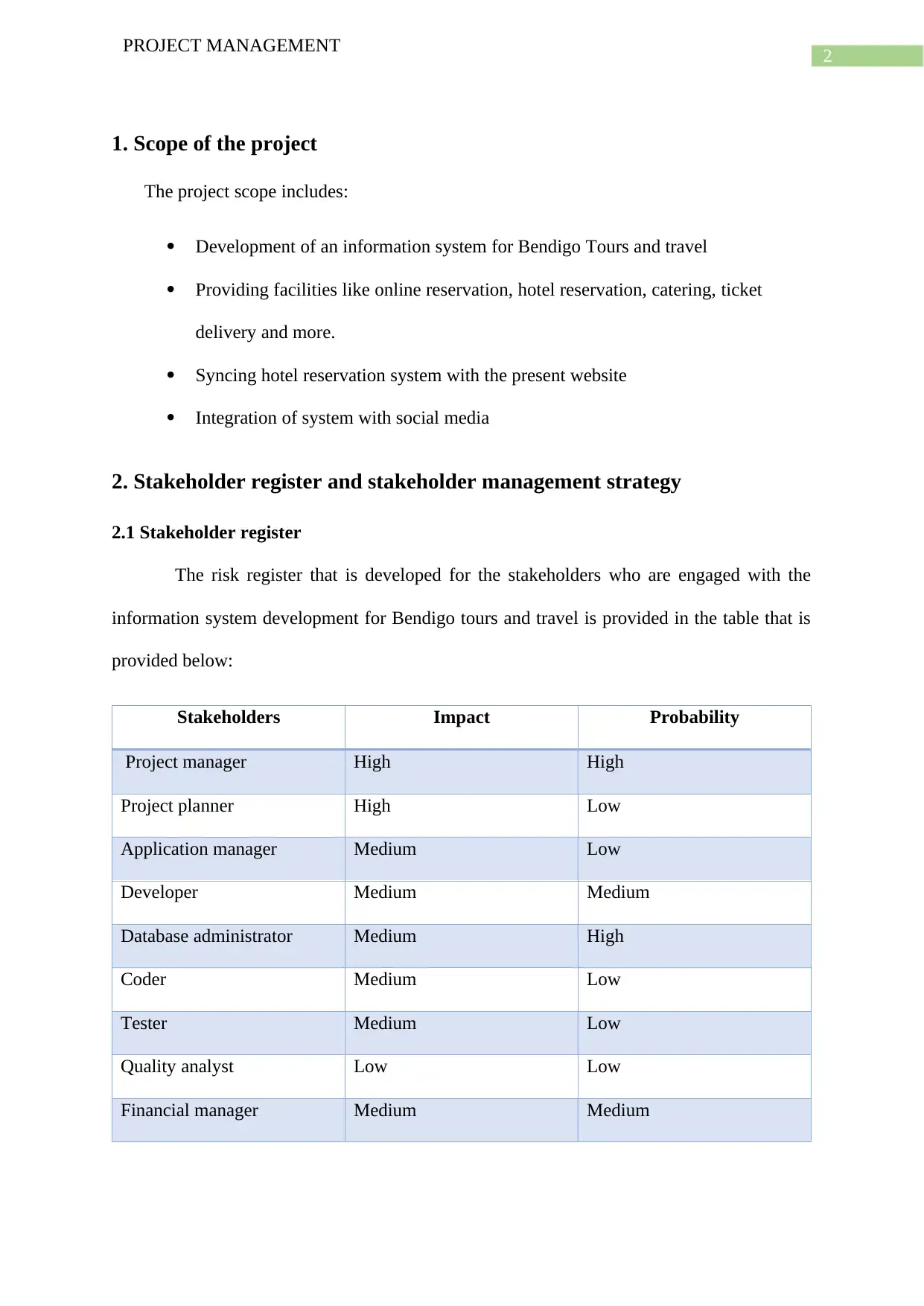
2
PROJECT MANAGEMENT
1. Scope of the project
The project scope includes:
Development of an information system for Bendigo Tours and travel
Providing facilities like online reservation, hotel reservation, catering, ticket
delivery and more.
Syncing hotel reservation system with the present website
Integration of system with social media
2. Stakeholder register and stakeholder management strategy
2.1 Stakeholder register
The risk register that is developed for the stakeholders who are engaged with the
information system development for Bendigo tours and travel is provided in the table that is
provided below:
Stakeholders Impact Probability
Project manager High High
Project planner High Low
Application manager Medium Low
Developer Medium Medium
Database administrator Medium High
Coder Medium Low
Tester Medium Low
Quality analyst Low Low
Financial manager Medium Medium
PROJECT MANAGEMENT
1. Scope of the project
The project scope includes:
Development of an information system for Bendigo Tours and travel
Providing facilities like online reservation, hotel reservation, catering, ticket
delivery and more.
Syncing hotel reservation system with the present website
Integration of system with social media
2. Stakeholder register and stakeholder management strategy
2.1 Stakeholder register
The risk register that is developed for the stakeholders who are engaged with the
information system development for Bendigo tours and travel is provided in the table that is
provided below:
Stakeholders Impact Probability
Project manager High High
Project planner High Low
Application manager Medium Low
Developer Medium Medium
Database administrator Medium High
Coder Medium Low
Tester Medium Low
Quality analyst Low Low
Financial manager Medium Medium
⊘ This is a preview!⊘
Do you want full access?
Subscribe today to unlock all pages.

Trusted by 1+ million students worldwide
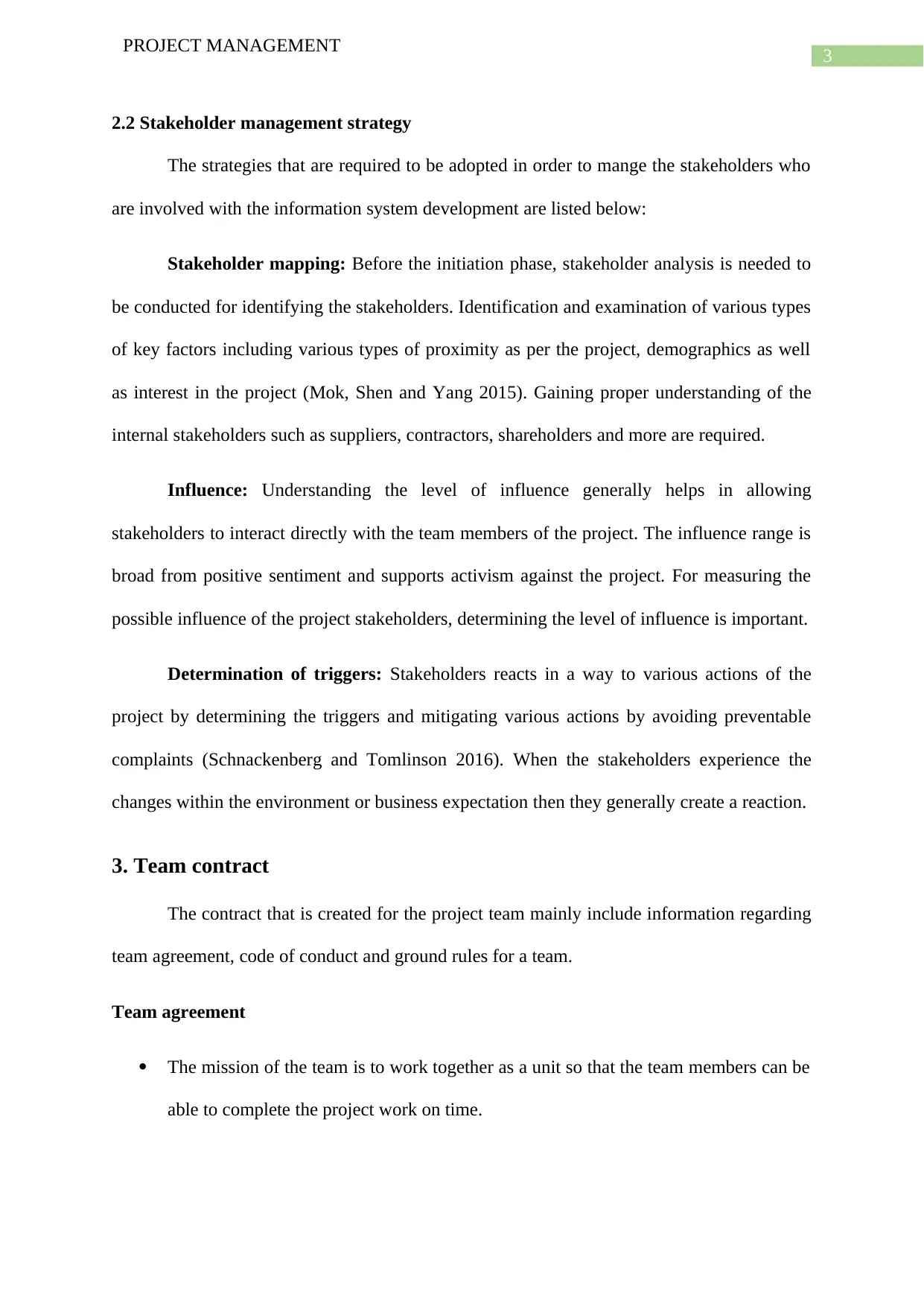
3
PROJECT MANAGEMENT
2.2 Stakeholder management strategy
The strategies that are required to be adopted in order to mange the stakeholders who
are involved with the information system development are listed below:
Stakeholder mapping: Before the initiation phase, stakeholder analysis is needed to
be conducted for identifying the stakeholders. Identification and examination of various types
of key factors including various types of proximity as per the project, demographics as well
as interest in the project (Mok, Shen and Yang 2015). Gaining proper understanding of the
internal stakeholders such as suppliers, contractors, shareholders and more are required.
Influence: Understanding the level of influence generally helps in allowing
stakeholders to interact directly with the team members of the project. The influence range is
broad from positive sentiment and supports activism against the project. For measuring the
possible influence of the project stakeholders, determining the level of influence is important.
Determination of triggers: Stakeholders reacts in a way to various actions of the
project by determining the triggers and mitigating various actions by avoiding preventable
complaints (Schnackenberg and Tomlinson 2016). When the stakeholders experience the
changes within the environment or business expectation then they generally create a reaction.
3. Team contract
The contract that is created for the project team mainly include information regarding
team agreement, code of conduct and ground rules for a team.
Team agreement
The mission of the team is to work together as a unit so that the team members can be
able to complete the project work on time.
PROJECT MANAGEMENT
2.2 Stakeholder management strategy
The strategies that are required to be adopted in order to mange the stakeholders who
are involved with the information system development are listed below:
Stakeholder mapping: Before the initiation phase, stakeholder analysis is needed to
be conducted for identifying the stakeholders. Identification and examination of various types
of key factors including various types of proximity as per the project, demographics as well
as interest in the project (Mok, Shen and Yang 2015). Gaining proper understanding of the
internal stakeholders such as suppliers, contractors, shareholders and more are required.
Influence: Understanding the level of influence generally helps in allowing
stakeholders to interact directly with the team members of the project. The influence range is
broad from positive sentiment and supports activism against the project. For measuring the
possible influence of the project stakeholders, determining the level of influence is important.
Determination of triggers: Stakeholders reacts in a way to various actions of the
project by determining the triggers and mitigating various actions by avoiding preventable
complaints (Schnackenberg and Tomlinson 2016). When the stakeholders experience the
changes within the environment or business expectation then they generally create a reaction.
3. Team contract
The contract that is created for the project team mainly include information regarding
team agreement, code of conduct and ground rules for a team.
Team agreement
The mission of the team is to work together as a unit so that the team members can be
able to complete the project work on time.
Paraphrase This Document
Need a fresh take? Get an instant paraphrase of this document with our AI Paraphraser
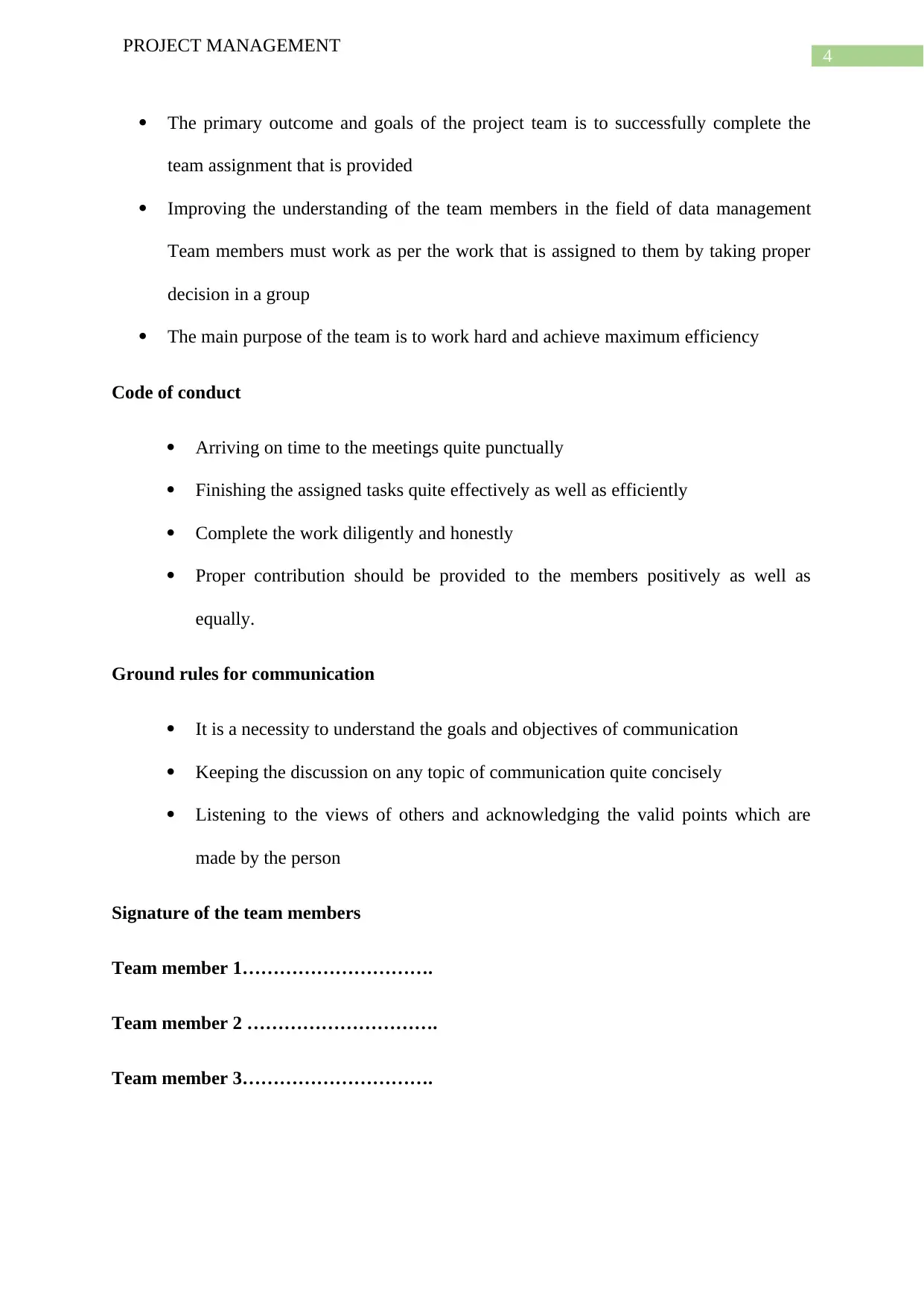
4
PROJECT MANAGEMENT
The primary outcome and goals of the project team is to successfully complete the
team assignment that is provided
Improving the understanding of the team members in the field of data management
Team members must work as per the work that is assigned to them by taking proper
decision in a group
The main purpose of the team is to work hard and achieve maximum efficiency
Code of conduct
Arriving on time to the meetings quite punctually
Finishing the assigned tasks quite effectively as well as efficiently
Complete the work diligently and honestly
Proper contribution should be provided to the members positively as well as
equally.
Ground rules for communication
It is a necessity to understand the goals and objectives of communication
Keeping the discussion on any topic of communication quite concisely
Listening to the views of others and acknowledging the valid points which are
made by the person
Signature of the team members
Team member 1………………………….
Team member 2 ………………………….
Team member 3………………………….
PROJECT MANAGEMENT
The primary outcome and goals of the project team is to successfully complete the
team assignment that is provided
Improving the understanding of the team members in the field of data management
Team members must work as per the work that is assigned to them by taking proper
decision in a group
The main purpose of the team is to work hard and achieve maximum efficiency
Code of conduct
Arriving on time to the meetings quite punctually
Finishing the assigned tasks quite effectively as well as efficiently
Complete the work diligently and honestly
Proper contribution should be provided to the members positively as well as
equally.
Ground rules for communication
It is a necessity to understand the goals and objectives of communication
Keeping the discussion on any topic of communication quite concisely
Listening to the views of others and acknowledging the valid points which are
made by the person
Signature of the team members
Team member 1………………………….
Team member 2 ………………………….
Team member 3………………………….
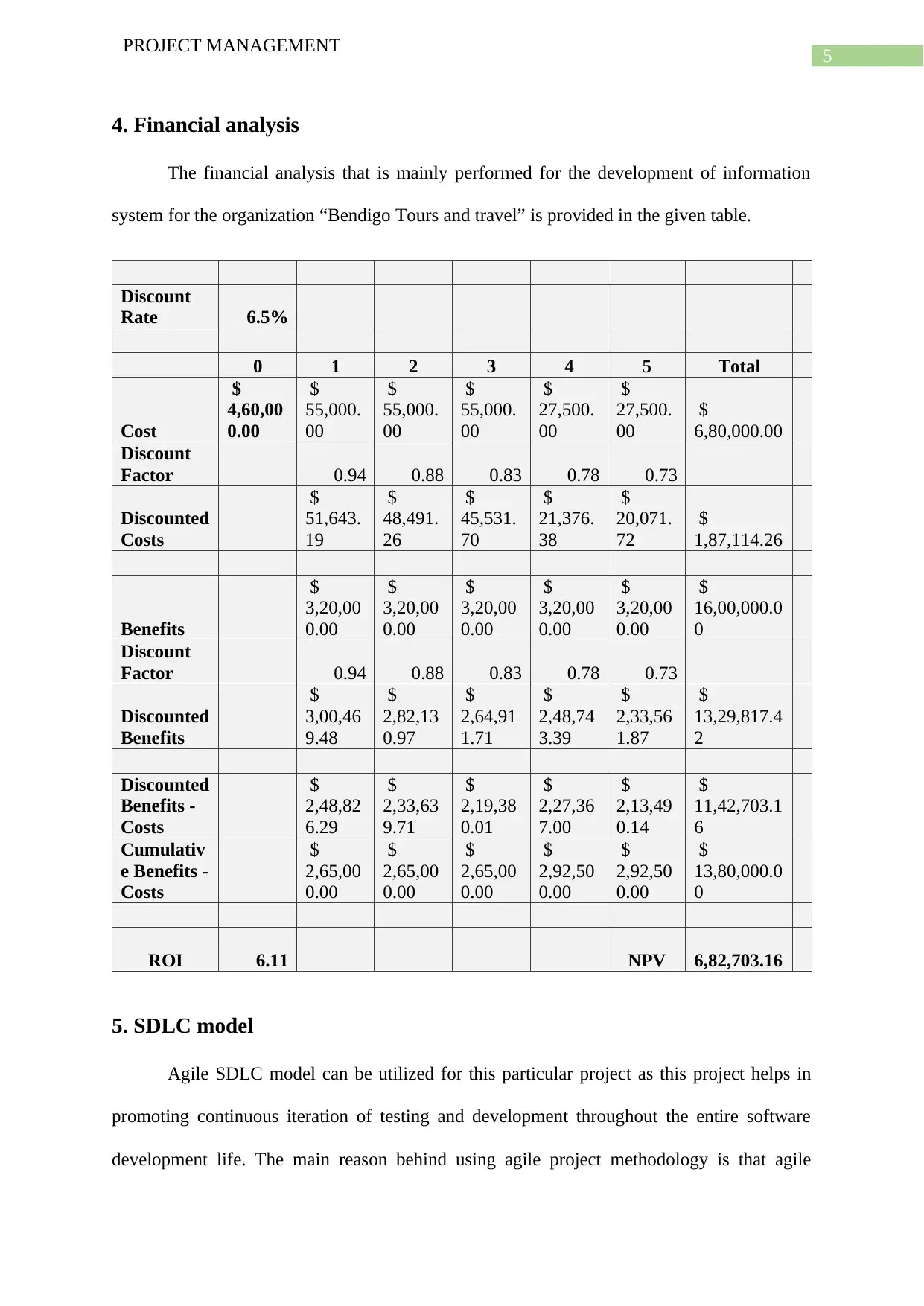
5
PROJECT MANAGEMENT
4. Financial analysis
The financial analysis that is mainly performed for the development of information
system for the organization “Bendigo Tours and travel” is provided in the given table.
Discount
Rate 6.5%
0 1 2 3 4 5 Total
Cost
$
4,60,00
0.00
$
55,000.
00
$
55,000.
00
$
55,000.
00
$
27,500.
00
$
27,500.
00
$
6,80,000.00
Discount
Factor 0.94 0.88 0.83 0.78 0.73
Discounted
Costs
$
51,643.
19
$
48,491.
26
$
45,531.
70
$
21,376.
38
$
20,071.
72
$
1,87,114.26
Benefits
$
3,20,00
0.00
$
3,20,00
0.00
$
3,20,00
0.00
$
3,20,00
0.00
$
3,20,00
0.00
$
16,00,000.0
0
Discount
Factor 0.94 0.88 0.83 0.78 0.73
Discounted
Benefits
$
3,00,46
9.48
$
2,82,13
0.97
$
2,64,91
1.71
$
2,48,74
3.39
$
2,33,56
1.87
$
13,29,817.4
2
Discounted
Benefits -
Costs
$
2,48,82
6.29
$
2,33,63
9.71
$
2,19,38
0.01
$
2,27,36
7.00
$
2,13,49
0.14
$
11,42,703.1
6
Cumulativ
e Benefits -
Costs
$
2,65,00
0.00
$
2,65,00
0.00
$
2,65,00
0.00
$
2,92,50
0.00
$
2,92,50
0.00
$
13,80,000.0
0
ROI 6.11 NPV 6,82,703.16
5. SDLC model
Agile SDLC model can be utilized for this particular project as this project helps in
promoting continuous iteration of testing and development throughout the entire software
development life. The main reason behind using agile project methodology is that agile
PROJECT MANAGEMENT
4. Financial analysis
The financial analysis that is mainly performed for the development of information
system for the organization “Bendigo Tours and travel” is provided in the given table.
Discount
Rate 6.5%
0 1 2 3 4 5 Total
Cost
$
4,60,00
0.00
$
55,000.
00
$
55,000.
00
$
55,000.
00
$
27,500.
00
$
27,500.
00
$
6,80,000.00
Discount
Factor 0.94 0.88 0.83 0.78 0.73
Discounted
Costs
$
51,643.
19
$
48,491.
26
$
45,531.
70
$
21,376.
38
$
20,071.
72
$
1,87,114.26
Benefits
$
3,20,00
0.00
$
3,20,00
0.00
$
3,20,00
0.00
$
3,20,00
0.00
$
3,20,00
0.00
$
16,00,000.0
0
Discount
Factor 0.94 0.88 0.83 0.78 0.73
Discounted
Benefits
$
3,00,46
9.48
$
2,82,13
0.97
$
2,64,91
1.71
$
2,48,74
3.39
$
2,33,56
1.87
$
13,29,817.4
2
Discounted
Benefits -
Costs
$
2,48,82
6.29
$
2,33,63
9.71
$
2,19,38
0.01
$
2,27,36
7.00
$
2,13,49
0.14
$
11,42,703.1
6
Cumulativ
e Benefits -
Costs
$
2,65,00
0.00
$
2,65,00
0.00
$
2,65,00
0.00
$
2,92,50
0.00
$
2,92,50
0.00
$
13,80,000.0
0
ROI 6.11 NPV 6,82,703.16
5. SDLC model
Agile SDLC model can be utilized for this particular project as this project helps in
promoting continuous iteration of testing and development throughout the entire software
development life. The main reason behind using agile project methodology is that agile
⊘ This is a preview!⊘
Do you want full access?
Subscribe today to unlock all pages.

Trusted by 1+ million students worldwide
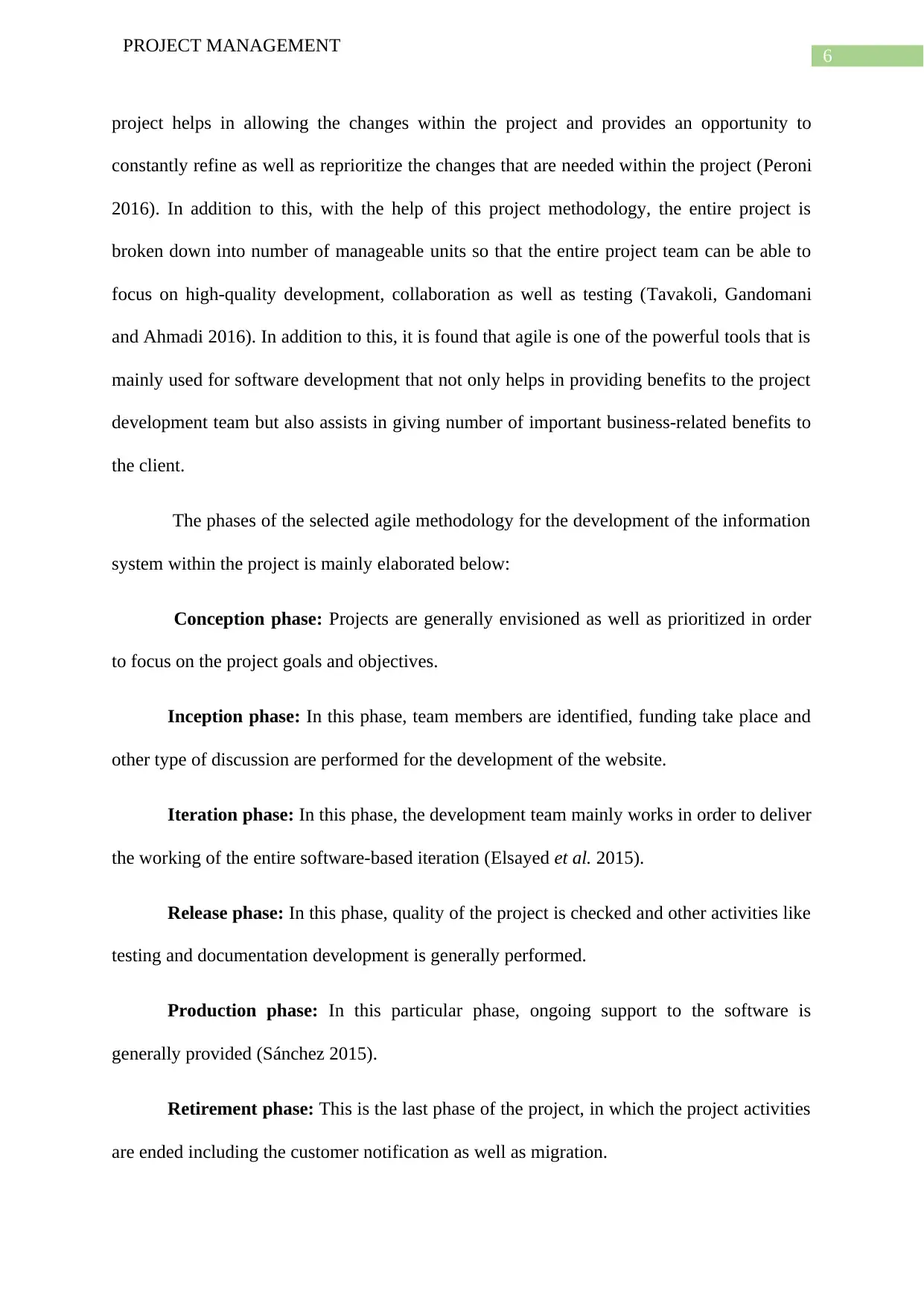
6
PROJECT MANAGEMENT
project helps in allowing the changes within the project and provides an opportunity to
constantly refine as well as reprioritize the changes that are needed within the project (Peroni
2016). In addition to this, with the help of this project methodology, the entire project is
broken down into number of manageable units so that the entire project team can be able to
focus on high-quality development, collaboration as well as testing (Tavakoli, Gandomani
and Ahmadi 2016). In addition to this, it is found that agile is one of the powerful tools that is
mainly used for software development that not only helps in providing benefits to the project
development team but also assists in giving number of important business-related benefits to
the client.
The phases of the selected agile methodology for the development of the information
system within the project is mainly elaborated below:
Conception phase: Projects are generally envisioned as well as prioritized in order
to focus on the project goals and objectives.
Inception phase: In this phase, team members are identified, funding take place and
other type of discussion are performed for the development of the website.
Iteration phase: In this phase, the development team mainly works in order to deliver
the working of the entire software-based iteration (Elsayed et al. 2015).
Release phase: In this phase, quality of the project is checked and other activities like
testing and documentation development is generally performed.
Production phase: In this particular phase, ongoing support to the software is
generally provided (Sánchez 2015).
Retirement phase: This is the last phase of the project, in which the project activities
are ended including the customer notification as well as migration.
PROJECT MANAGEMENT
project helps in allowing the changes within the project and provides an opportunity to
constantly refine as well as reprioritize the changes that are needed within the project (Peroni
2016). In addition to this, with the help of this project methodology, the entire project is
broken down into number of manageable units so that the entire project team can be able to
focus on high-quality development, collaboration as well as testing (Tavakoli, Gandomani
and Ahmadi 2016). In addition to this, it is found that agile is one of the powerful tools that is
mainly used for software development that not only helps in providing benefits to the project
development team but also assists in giving number of important business-related benefits to
the client.
The phases of the selected agile methodology for the development of the information
system within the project is mainly elaborated below:
Conception phase: Projects are generally envisioned as well as prioritized in order
to focus on the project goals and objectives.
Inception phase: In this phase, team members are identified, funding take place and
other type of discussion are performed for the development of the website.
Iteration phase: In this phase, the development team mainly works in order to deliver
the working of the entire software-based iteration (Elsayed et al. 2015).
Release phase: In this phase, quality of the project is checked and other activities like
testing and documentation development is generally performed.
Production phase: In this particular phase, ongoing support to the software is
generally provided (Sánchez 2015).
Retirement phase: This is the last phase of the project, in which the project activities
are ended including the customer notification as well as migration.
Paraphrase This Document
Need a fresh take? Get an instant paraphrase of this document with our AI Paraphraser
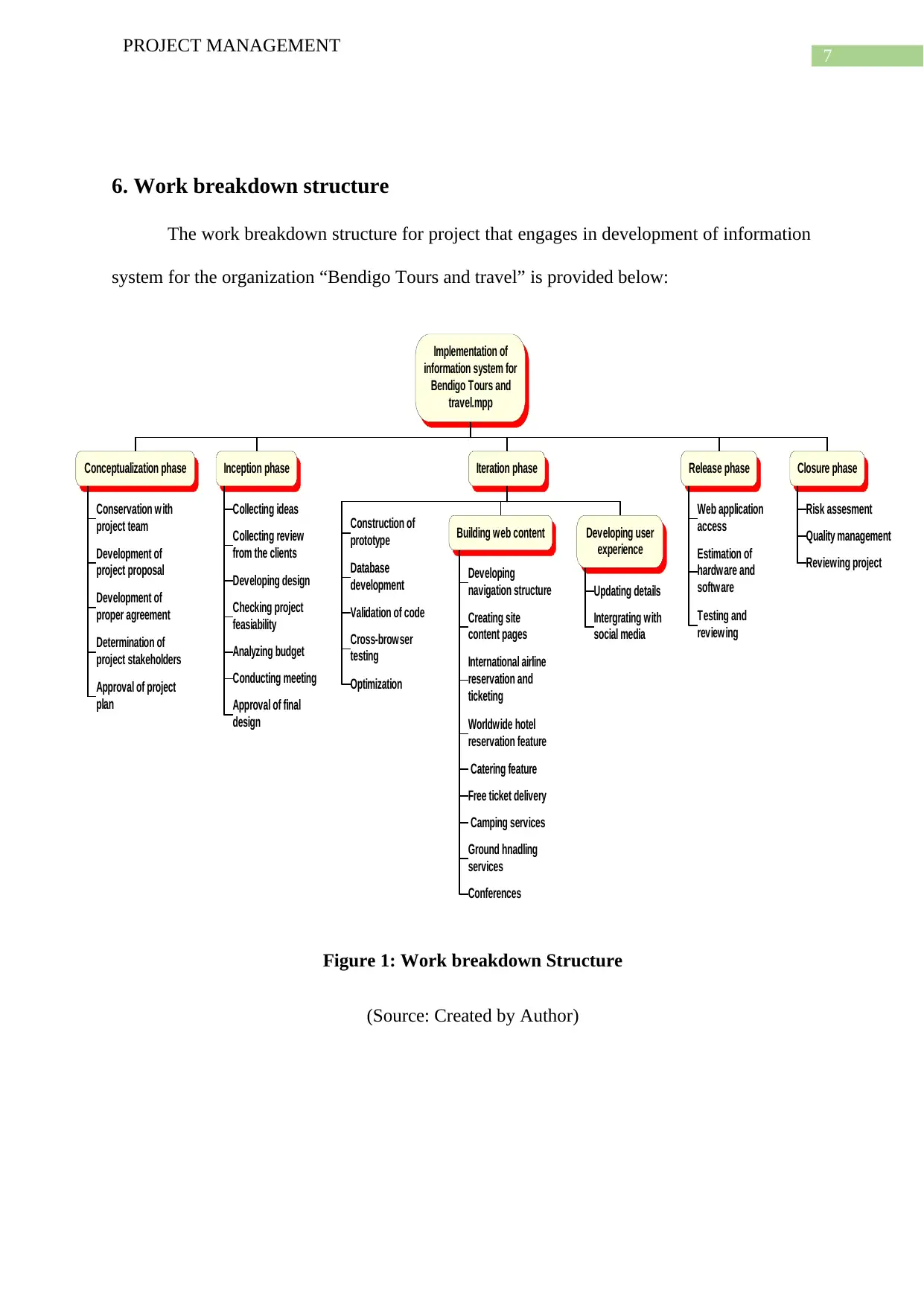
7
PROJECT MANAGEMENT
6. Work breakdown structure
The work breakdown structure for project that engages in development of information
system for the organization “Bendigo Tours and travel” is provided below:
Implementation of
information system for
Bendigo Tours and
travel.mpp
Conceptualization phase
Conservation w ith
project team
Development of
project proposal
Development of
proper agreement
Determination of
project stakeholders
Approval of project
plan
Inception phase
Collecting ideas
Collecting review
from the clients
Developing design
Checking project
feasiability
Analyzing budget
Conducting meeting
Approval of final
design
Iteration phase
Construction of
prototype
Database
development
Validation of code
Cross-browser
testing
Optimization
Building web content
Developing
navigation structure
Creating site
content pages
International airline
reservation and
ticketing
Worldwide hotel
reservation feature
Catering feature
Free ticket delivery
Camping services
Ground hnadling
services
Conferences
Developing user
experience
Updating details
Intergrating with
social media
Release phase
Web application
access
Estimation of
hardware and
software
Testing and
review ing
Closure phase
Risk assesment
Quality management
Reviewing project
Figure 1: Work breakdown Structure
(Source: Created by Author)
PROJECT MANAGEMENT
6. Work breakdown structure
The work breakdown structure for project that engages in development of information
system for the organization “Bendigo Tours and travel” is provided below:
Implementation of
information system for
Bendigo Tours and
travel.mpp
Conceptualization phase
Conservation w ith
project team
Development of
project proposal
Development of
proper agreement
Determination of
project stakeholders
Approval of project
plan
Inception phase
Collecting ideas
Collecting review
from the clients
Developing design
Checking project
feasiability
Analyzing budget
Conducting meeting
Approval of final
design
Iteration phase
Construction of
prototype
Database
development
Validation of code
Cross-browser
testing
Optimization
Building web content
Developing
navigation structure
Creating site
content pages
International airline
reservation and
ticketing
Worldwide hotel
reservation feature
Catering feature
Free ticket delivery
Camping services
Ground hnadling
services
Conferences
Developing user
experience
Updating details
Intergrating with
social media
Release phase
Web application
access
Estimation of
hardware and
software
Testing and
review ing
Closure phase
Risk assesment
Quality management
Reviewing project
Figure 1: Work breakdown Structure
(Source: Created by Author)
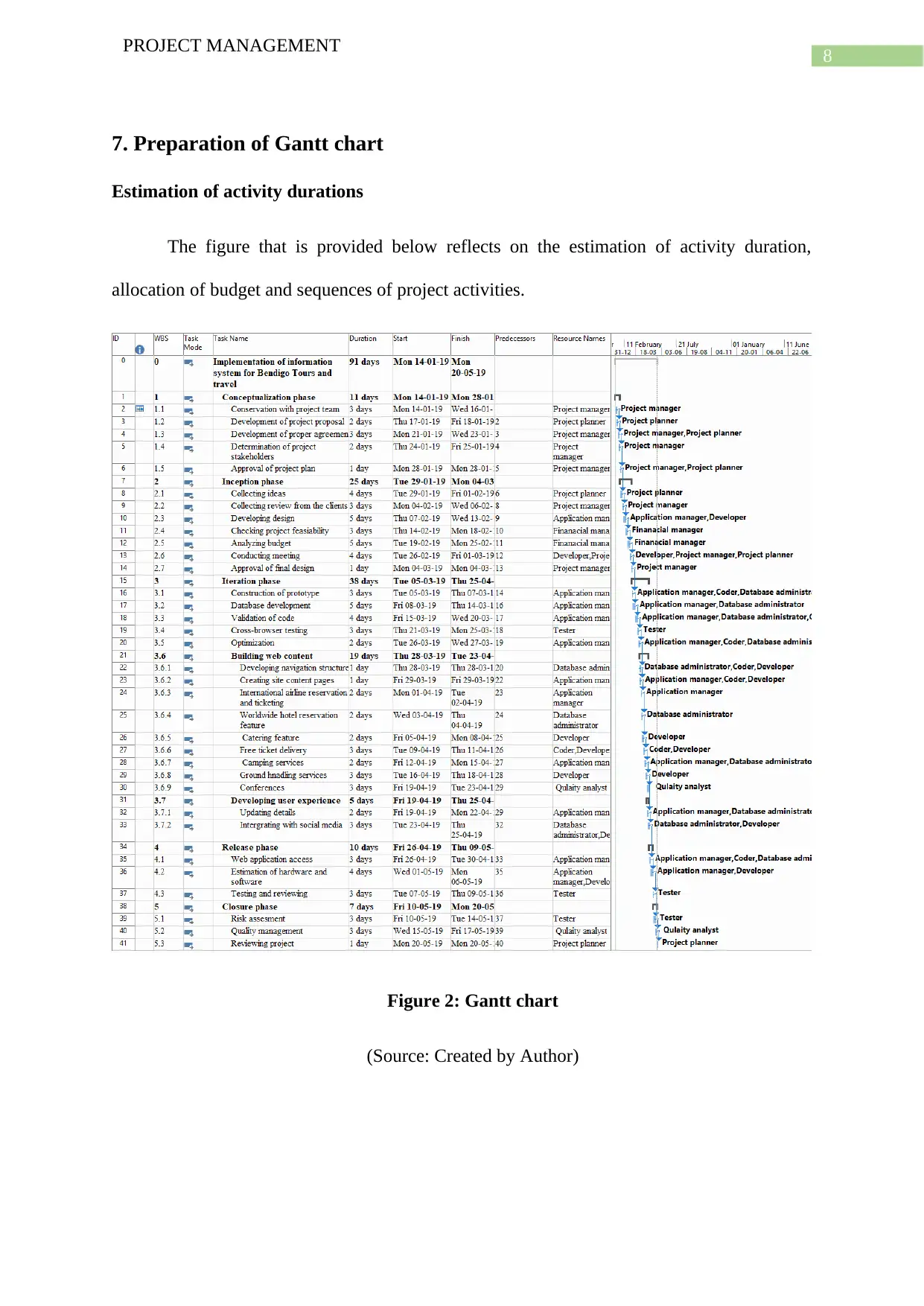
8
PROJECT MANAGEMENT
7. Preparation of Gantt chart
Estimation of activity durations
The figure that is provided below reflects on the estimation of activity duration,
allocation of budget and sequences of project activities.
Figure 2: Gantt chart
(Source: Created by Author)
PROJECT MANAGEMENT
7. Preparation of Gantt chart
Estimation of activity durations
The figure that is provided below reflects on the estimation of activity duration,
allocation of budget and sequences of project activities.
Figure 2: Gantt chart
(Source: Created by Author)
⊘ This is a preview!⊘
Do you want full access?
Subscribe today to unlock all pages.

Trusted by 1+ million students worldwide
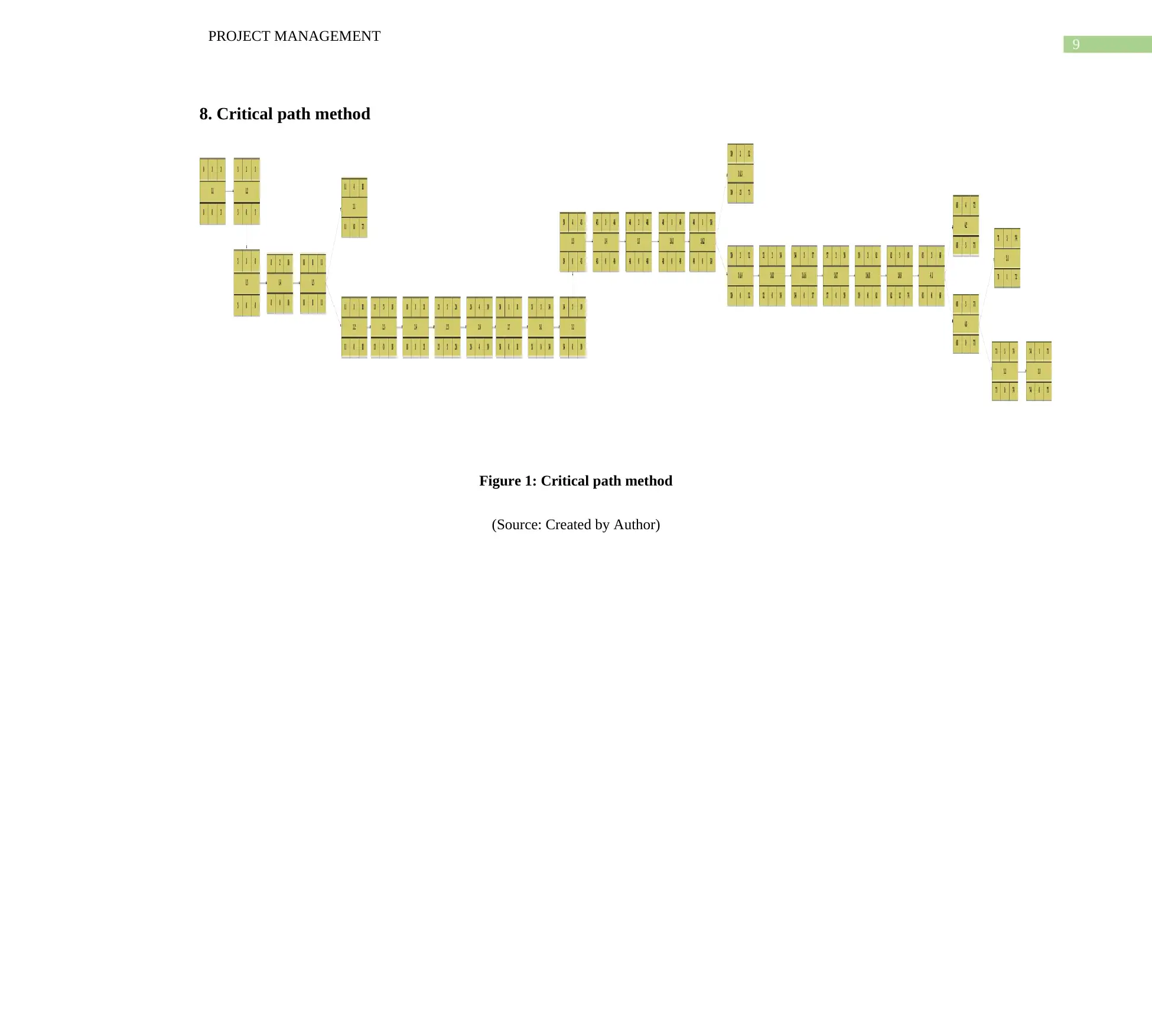
9
PROJECT MANAGEMENT
8. Critical path method
Figure 1: Critical path method
(Source: Created by Author)
PROJECT MANAGEMENT
8. Critical path method
Figure 1: Critical path method
(Source: Created by Author)
Paraphrase This Document
Need a fresh take? Get an instant paraphrase of this document with our AI Paraphraser
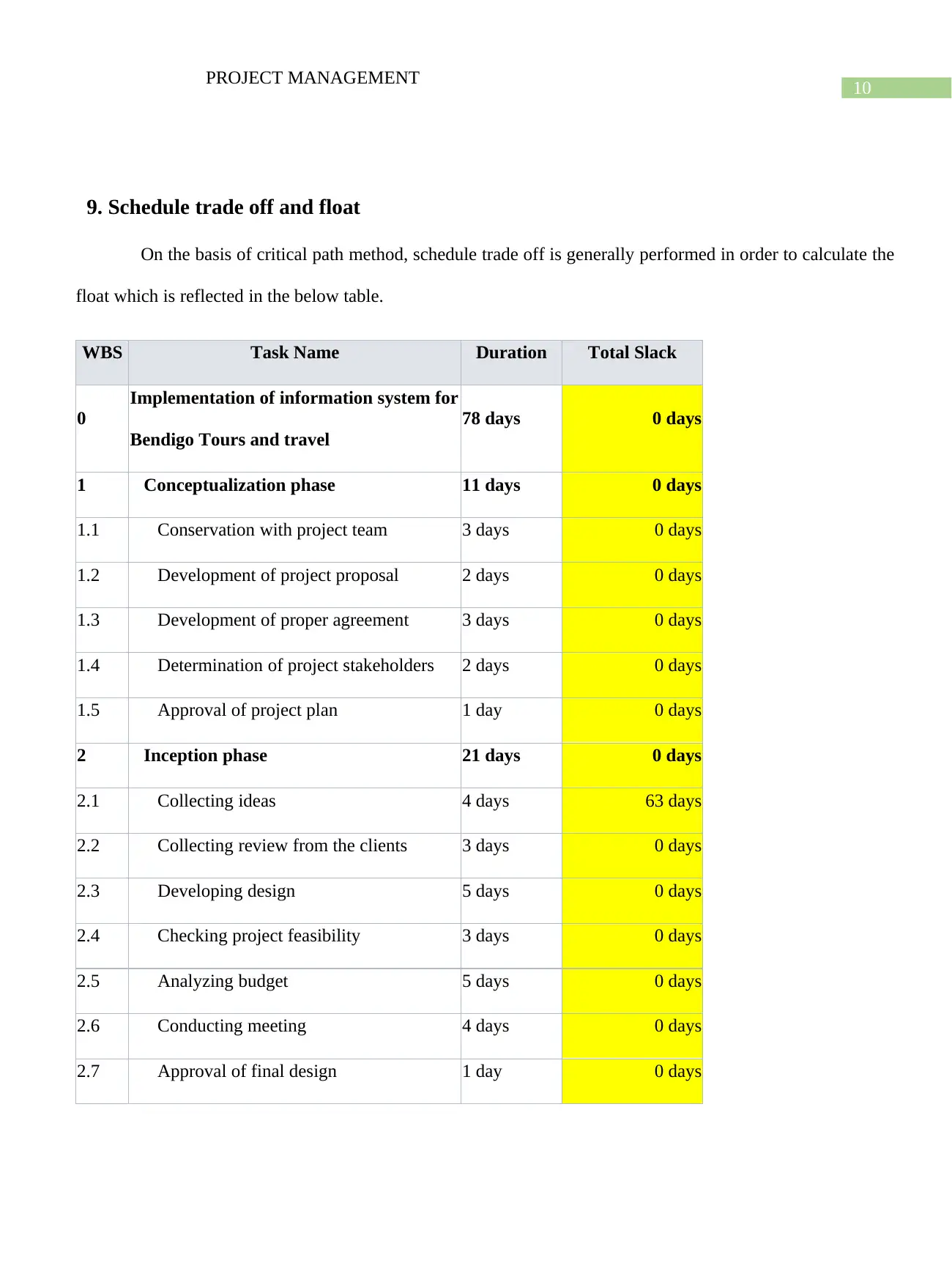
10
PROJECT MANAGEMENT
9. Schedule trade off and float
On the basis of critical path method, schedule trade off is generally performed in order to calculate the
float which is reflected in the below table.
WBS Task Name Duration Total Slack
0
Implementation of information system for
Bendigo Tours and travel
78 days 0 days
1 Conceptualization phase 11 days 0 days
1.1 Conservation with project team 3 days 0 days
1.2 Development of project proposal 2 days 0 days
1.3 Development of proper agreement 3 days 0 days
1.4 Determination of project stakeholders 2 days 0 days
1.5 Approval of project plan 1 day 0 days
2 Inception phase 21 days 0 days
2.1 Collecting ideas 4 days 63 days
2.2 Collecting review from the clients 3 days 0 days
2.3 Developing design 5 days 0 days
2.4 Checking project feasibility 3 days 0 days
2.5 Analyzing budget 5 days 0 days
2.6 Conducting meeting 4 days 0 days
2.7 Approval of final design 1 day 0 days
PROJECT MANAGEMENT
9. Schedule trade off and float
On the basis of critical path method, schedule trade off is generally performed in order to calculate the
float which is reflected in the below table.
WBS Task Name Duration Total Slack
0
Implementation of information system for
Bendigo Tours and travel
78 days 0 days
1 Conceptualization phase 11 days 0 days
1.1 Conservation with project team 3 days 0 days
1.2 Development of project proposal 2 days 0 days
1.3 Development of proper agreement 3 days 0 days
1.4 Determination of project stakeholders 2 days 0 days
1.5 Approval of project plan 1 day 0 days
2 Inception phase 21 days 0 days
2.1 Collecting ideas 4 days 63 days
2.2 Collecting review from the clients 3 days 0 days
2.3 Developing design 5 days 0 days
2.4 Checking project feasibility 3 days 0 days
2.5 Analyzing budget 5 days 0 days
2.6 Conducting meeting 4 days 0 days
2.7 Approval of final design 1 day 0 days
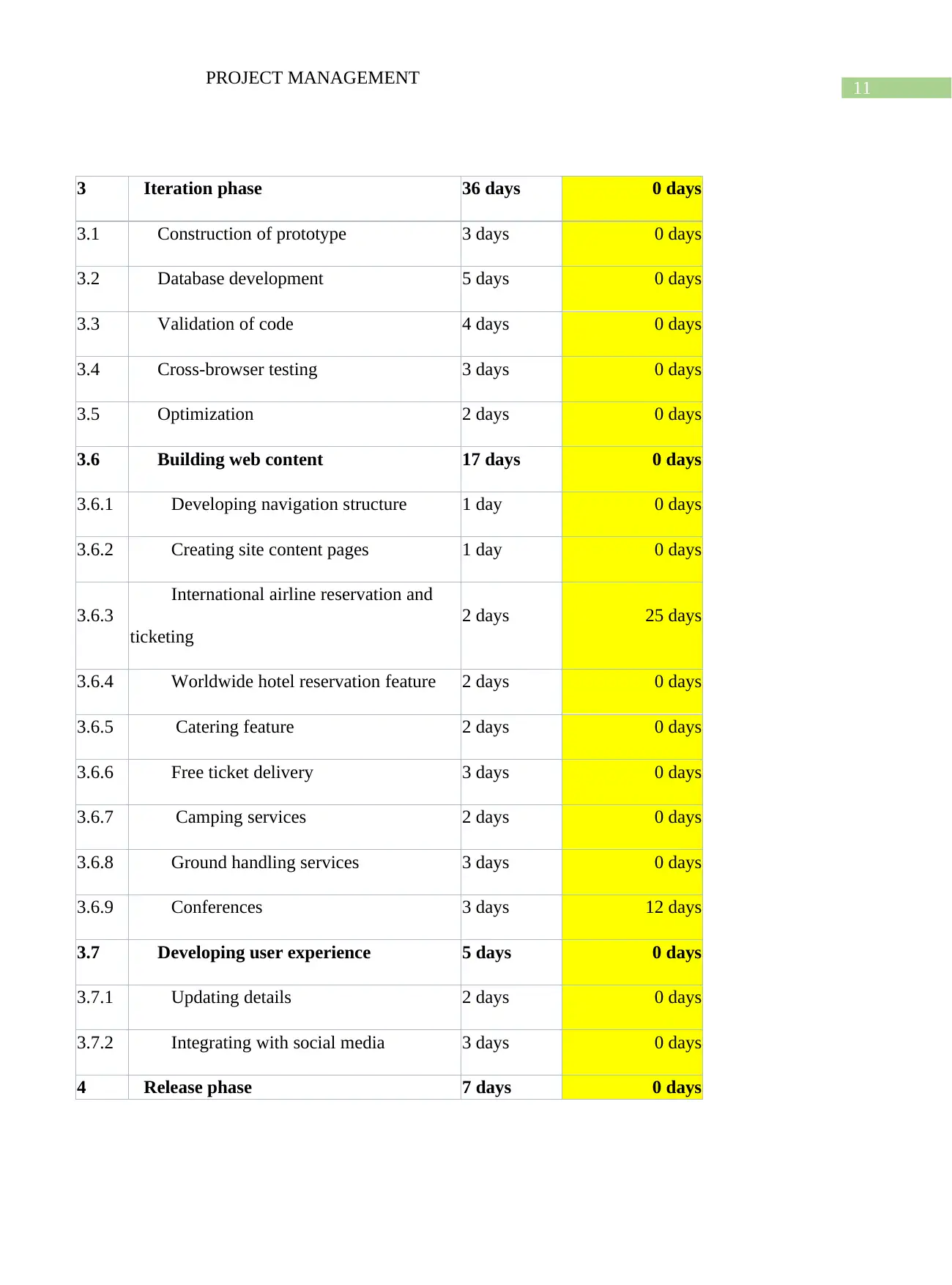
11
PROJECT MANAGEMENT
3 Iteration phase 36 days 0 days
3.1 Construction of prototype 3 days 0 days
3.2 Database development 5 days 0 days
3.3 Validation of code 4 days 0 days
3.4 Cross-browser testing 3 days 0 days
3.5 Optimization 2 days 0 days
3.6 Building web content 17 days 0 days
3.6.1 Developing navigation structure 1 day 0 days
3.6.2 Creating site content pages 1 day 0 days
3.6.3
International airline reservation and
ticketing
2 days 25 days
3.6.4 Worldwide hotel reservation feature 2 days 0 days
3.6.5 Catering feature 2 days 0 days
3.6.6 Free ticket delivery 3 days 0 days
3.6.7 Camping services 2 days 0 days
3.6.8 Ground handling services 3 days 0 days
3.6.9 Conferences 3 days 12 days
3.7 Developing user experience 5 days 0 days
3.7.1 Updating details 2 days 0 days
3.7.2 Integrating with social media 3 days 0 days
4 Release phase 7 days 0 days
PROJECT MANAGEMENT
3 Iteration phase 36 days 0 days
3.1 Construction of prototype 3 days 0 days
3.2 Database development 5 days 0 days
3.3 Validation of code 4 days 0 days
3.4 Cross-browser testing 3 days 0 days
3.5 Optimization 2 days 0 days
3.6 Building web content 17 days 0 days
3.6.1 Developing navigation structure 1 day 0 days
3.6.2 Creating site content pages 1 day 0 days
3.6.3
International airline reservation and
ticketing
2 days 25 days
3.6.4 Worldwide hotel reservation feature 2 days 0 days
3.6.5 Catering feature 2 days 0 days
3.6.6 Free ticket delivery 3 days 0 days
3.6.7 Camping services 2 days 0 days
3.6.8 Ground handling services 3 days 0 days
3.6.9 Conferences 3 days 12 days
3.7 Developing user experience 5 days 0 days
3.7.1 Updating details 2 days 0 days
3.7.2 Integrating with social media 3 days 0 days
4 Release phase 7 days 0 days
⊘ This is a preview!⊘
Do you want full access?
Subscribe today to unlock all pages.

Trusted by 1+ million students worldwide
1 out of 20
Related Documents
Your All-in-One AI-Powered Toolkit for Academic Success.
+13062052269
info@desklib.com
Available 24*7 on WhatsApp / Email
![[object Object]](/_next/static/media/star-bottom.7253800d.svg)
Unlock your academic potential
Copyright © 2020–2025 A2Z Services. All Rights Reserved. Developed and managed by ZUCOL.





